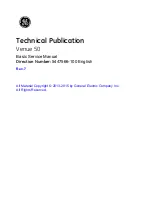
Rev. 2/8/2019
E-TUG MANUAL
Copyright 2019 Vestil Manufacturing Corp.
Page
5
of
7
RECORD OF NORMAL CONDITION:
Before using the product for the first time, make a written record of its appearance and operation. Drive the unit
forward and in reverse. Describe the motion (e.g. smooth and constant; comfortable walking pace). Include a
description of how the unit sounds while in motion. Also describe how the unit stops. How long does it take for the unit
to stop a various speeds? Drive the tugger in reverse and press the belly switch. Explain how the unit reacts to the
switch. Thoroughly photograph the unit and each label applied to it. Add the photos to the record. Describe where
each label is located.
This record establishes normal condition
. Whenever the unit is inspected, compare those
observations to the record to determine if the mover is in normal condition. Do not use it unless it is in normal
condition. Cosmetic changes, like damaged paint/powder coat and scratches on the housing do not constitute
changes from normal condition. However, touchup paint should be applied to all areas where the coating is damaged
as soon as damage occurs.
INSPECTIONS & MAINTENANCE:
Refer to the diagrams on pages
Proper storage and maintenance is essential to keep this product in normal condition and to
maximize the service life of the unit.
•
Always store the unit indoors in a dry location.
•
DO NOT use it outdoors if it is raining, snowing, etc. The E-TUG must be kept dry.
Regular inspections and maintenance are necessary for this device to remain serviceable for as long as possible.
Compare all observations made during an inspection to the
Record of Normal Condition
. Before performing any
inspection, make sure that the E-stop is engaged by pressing down the (red) button. If problems are discovered
during an inspection, restore the machine to normal condition before returning it to service. Contact the
if you need assistance with an issue discovered during an inspection.
A. Before each use – Each time the E-TUG is used the following components should be inspected beforehand.
1. Drive wheels and casters – Disengage the E-stop by pulling up the red button. Drive the tugger a short
distance in both directions. Confirm that it rolls smoothly, without wobbling. Engage the E-stop by pushing
the button down.
2. Yoke and handle – Move the handle down and release it. Confirm that the yoke returns to its home position.
3. Receiver and hitch pin – Make sure that the receiver is securely fastened to the mounting plate and the
hitch pin is in place.
4. Labels – Make sure that all labels are easily readable.
B. At least once per month perform the following inspections:
1. Drive wheels and tires – This machine is equipped with solid foam tires and therefore require no inflation.
Check the tires for punctures, cracks, and severe wear. Replace a tire if it is damaged or its tread is
significantly worn. Pull the E-stop button up and drive the unit a short distance both forward and reverse.
Listen for unusual sounds and watch for atypical movement as the unit moves. Press the E-stop button
down.
2. Casters – Check each caster wheel for punctures, cuts, and severe wear. The rear casters (2) should
swivel freely. All 3 casters should roll smoothly without wobbling or skidding. They should all be solidly
attached to the E-TUG frame. Caster axels and threaded stems should be straight. Replace a caster if it is
severely worn, bent, or damaged.
3. (Yellow) Housing/Cover – The cover should not be broken, torn, punctured, etc. Clasps should securely
fasten the cover to the frame of the machine.
4. Receiver and hitch pin – Make sure that the receiver and hitch pin are in place and in normal condition.
Tighten the machine screws, if necessary. Examine the mounting plate for damage such as warping around
the machine screws.
5. Yoke, handle, and movement controls – Examine the yoke, handle, and controls for damage. Confirm that
the yoke moves up and down and rotates normally side-to-side. Push the handle down and release it. The
yoke should return to home position (vertical). Verify that the movement controls rotates normally and return
to home position when released.
6. Batteries – Unbuckle the clasps and remove the yellow cover. Examine the batteries. Make sure that cables
are securely fastened to the battery terminals. Remove corrosion from the terminals 1-at-a-time. DO NOT
contact more than 1 battery terminal at the same time.
7. Labels – Replace damaged labels. All label content must be clearly visible.
TROUBLESHOOTING:
If you encounter an issue with the machine, contact the
department for assistance. Contact
information is provided on the cover page of this manual.

























